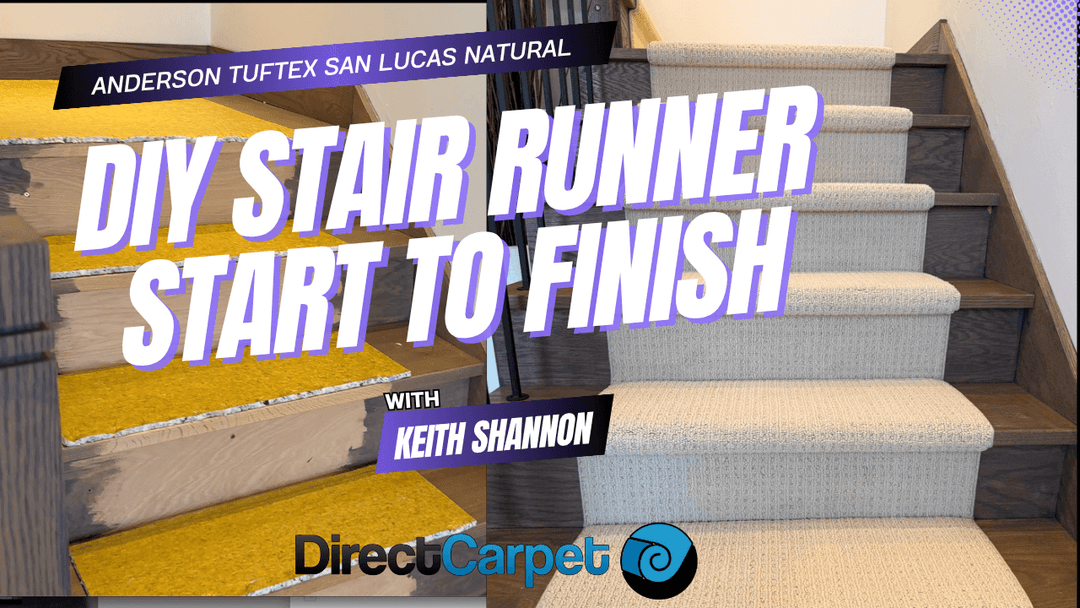Best Tips & Tricks for Installing Carpet Runner on Stairs

Introduction to Installing Carpet
Installing a stair runner is a fantastic way to add comfort, style, and safety to your staircase.
A well-installed stair runner can help reduce noise, prevent slipping, and protect your stairs from wear and tear.
With the right materials and tools, you can install a stair runner yourself, even if you’re a beginner.
In this section, we’ll introduce you to the basics of stair runner installation and provide you with the information you need to get started.
Whether you’re looking to enhance the aesthetic appeal of your stairs or add a layer of protection, installing a stair runner is a rewarding DIY project that can transform your staircase.

What is a Carpet Runner?
A carpet runner is a long piece of carpet designed for use on stairs, hallways, or even as a doormat.
They add style and comfort to your space while providing some extra safety.
Carpet padding is crucial in ensuring a safe and aesthetically pleasing installation. The first step in choosing a stair runner is selecting the right material and style.
Sizes:
Carpet runners come in different lengths and widths:
-
Lengths: Runners can be as short as 3 feet and can go up to 28 feet long.
-
Widths: They typically range from 24 inches to 36 inches wide.
Materials:
You can find carpet runners made from various materials, including:
-
Polypropylene: Durable and easy to clean.
-
Nylon: Strong and resistant to stains.
-
Wool: Soft and luxurious, but may need more care.
-
Rug pads play a significant role in enhancing stability and comfort.
-
Certain carpet materials can catch on pets’ claws, so choosing the right material can minimize this issue.
-
It’s also important to use a rug pad when installing stair runners, wrapping it around the stair bullnose and using carpet tape for extra hold to ensure durability and comfort.
Styles and Patterns:

Carpet runners come in many colors and patterns, allowing you to choose one that fits your style. Some popular patterns include:
-
Berber: A looped texture that’s both stylish and durable.
-
Herringbone: A classic zigzag design that adds elegance. Measuring stair treads and risers is essential for proper fitting and alignment of the runner.
-
Geometric: Fun shapes and designs that can add a modern touch. Knowing the width of the runner is important to ensure proper coverage and fit.
High-end installations like the French cap method result in a sophisticated, custom appearance that can significantly enhance your home's decor.
Whether you want to enhance your staircase, make your hallway cozier, or add a decorative doormat, a carpet runner is a great choice!
What Are Stair Runners?

Stair runners are narrow strips of carpeting that cover the center of a staircase, leaving some of the wood exposed on either side.
This design not only adds a touch of elegance but also allows homeowners to showcase the beauty of their wooden stairs.
Stair runners come in a variety of materials, patterns, and colors, making it easy to find one that perfectly matches your home’s decor.
Whether you prefer the natural look of sisal, the durability of synthetic carpet, or the classic appeal of hardwood, there’s a stair runner to suit your style.
When it comes to installation, there are several methods to choose from. It is important to secure the runner to the first riser for a neat finish.
The waterfall method, for instance, involves draping the carpet over the edge of each step, creating a smooth, continuous flow.
Alternatively, the French cap method wraps the carpet around the edge of each tread, providing a more tailored look.
No matter which method you choose, a well-installed stair runner can transform your staircase into a stunning focal point.
Ensuring that the stair runner is properly centered is crucial for both aesthetic and functional reasons.
Additionally, installing stair rods can enhance the overall look of the staircase and help cover imperfections in the transitions between runners, providing a structured and polished finish to the installation.
Securing the outer edges of the runner is essential for a clean and consistent look.

Benefits of Stair Runners
Stair runners offer a multitude of benefits that go beyond mere aesthetics. Firstly, they provide a soft cushion underfoot, making each step more comfortable.
This is especially beneficial in high-traffic areas where the constant pounding of feet can take a toll on your stairs.
Additionally, stair runners significantly reduce noise, creating a quieter and more peaceful home environment.
The difference a stair runner can make in terms of noise reduction and comfort is substantial.
Safety is another major advantage. Soft, carpeted stairs can help mitigate injuries from falls compared to landing on hard surfaces.
Stair runners can help prevent slips and falls, making them an excellent choice for homes with young children or elderly residents.
They also offer a practical solution for stairs with surface blemishes, effectively hiding imperfections and protecting the underlying floor from further wear and tear.
In essence, stair runners combine beauty and functionality, enhancing both the look and safety of your staircase.

Choosing the Right Material
Selecting the right material for your stair runner is crucial for both durability and safety.
For high-traffic areas, a low-pile carpet is ideal as it can withstand constant use without showing signs of wear.
Synthetic nylon, particularly in a twisted or cut low-pile form, is a fantastic option due to its durability and stain resistance.
Another excellent choice is high-quality nylon Berber carpet, known for its robustness and ability to resist stains.
It’s also important to ensure that the carpet is not slippery, as this can pose a safety risk. A carpet with a pile height of 1/2 inch or less is recommended to prevent wrapping around the nosing of the stairs, which can cause tripping.
A thick carpet that wraps around the nosing, or front edge of the stairs, can create a hazardous situation by acting as a down ramp, which may lead to slips and falls.
By choosing the right material, you can enjoy a beautiful, long-lasting stair runner that enhances the safety and appearance of your home.
Additionally, measuring the depth of the stair tread is crucial to ensure the correct size for carpet runners and padding.
Wooden elements, such as stair treads and stringers, can be stained to match the stair runner, ensuring a cohesive and aesthetically pleasing look.
Preparing for Installation

Before you dive into installing your stair runner, it’s crucial to prepare both the stairs and the surrounding area. Start by clearing the stairs of any debris, dust, or remnants of old carpeting.
A thorough vacuuming will ensure a clean surface, which is essential for a smooth installation.
Next, inspect each stair for any damage or unevenness that could affect the installation process. Address any necessary repairs to create a stable and even surface.
Finally, measure the width and length of your stairs to determine the correct dimensions for your stair runner. Accurate measurements will ensure a perfect fit and a professional-looking finish.
It's important to start the installation at the first tread for proper alignment.
When cutting your stair runner, be sure to leave a few inches of extra material for adjustments.
Measuring the Stairs
Measuring your stairs accurately is a crucial step in installing a stair runner. Start by measuring the depth of one stair tread, from the front edge to the back edge.
Then, measure the height of one stair riser, from the top of the tread to the bottom of the riser. Use a tape measure to get precise measurements, and make sure to take note of any landings or turns in your staircase.
Accurate measurements will ensure that your stair runner fits perfectly, covering each stair tread and riser without any gaps or overlaps. This step is essential for achieving a professional-looking installation.
Materials Needed

To successfully install a stair runner, you’ll need to gather the following materials:
-
Stair runner carpet** or rug**: Choose a runner that complements your home’s decor and fits the dimensions of your stairs.
-
Carpet padding (underlayment): This provides cushioning and support, extending the life of your carpet.
-
Double-sided carpet tape: Essential for securing the runner and padding in place. Make sure to use two strips of tape on the front and rear ends of the stair treads to prevent slumping and ensure a secure fit over time.
-
Staple gun: For attaching the runner to the stairs securely.
-
Utility knife or carpet cutter: To trim the carpet and padding to the correct size.
-
Measuring tape: For accurate measurements of your stairs and runner.
-
Pencil and marker: To mark measurements and layout marks.
-
Ruler or straightedge: To ensure straight cuts and edges, especially when cutting wood strips for a polished finish.
-
Safety glasses and gloves (optional): For protection during the installation process.
Having all these materials on hand before you start will make the installation process smoother and more efficient.
Cutting the Carpet

Once you have your measurements, it’s time to cut the carpet to the correct size.
Use a utility knife or carpet cutter to cut the carpet, and make sure to leave a little extra material around the edges.
This extra material will allow for adjustments during installation. You’ll also need to cut the carpet padding to the correct size, using a utility knife or carpet cutter.
Make sure to cut the padding slightly smaller than the carpet, so it fits snugly underneath.
When cutting the carpet, use a straight edge or a template to ensure a straight cut, and use a carpet cutter or a sharp utility knife to prevent fraying.
Precision in cutting will make the installation process smoother and the final result more polished.
Installing Carpet Padding

Carpet padding is a crucial component of stair runner installation, providing cushioning, noise reduction, and extending the life of your carpet. Begin by measuring the width of each stair tread and cutting the carpet padding to size.
Apply double-sided carpet tape to the back of the padding, ensuring it adheres securely. Starting at the bottom stair, attach the padding to the tread, smoothing out any wrinkles or air pockets as you go.
Remember to clip the corners of the pad to ensure a smoother fit around the nosing of the stairs.
Work your way up the stairs, ensuring each piece of padding is firmly in place.
Pull the padding taut but without excessive force to create a stable base for your stair runner, enhancing both comfort and durability.
Securing the Stair Runner

Securing your stair runner properly is essential for both safety and aesthetics. Begin by using a staple gun to attach the runner to the stair riser and tread.
Ensure you staple through the carpet and into the padding for a secure hold. Apply double-sided carpet tape to the stair nose and any other areas where the runner might slip. This will keep the runner taut and in place.
It is important to secure the runner to the bottom riser for a neat finish.
Use a utility knife or carpet cutter to trim any excess carpet or padding, ensuring a clean, finished edge. A ruler or straightedge can help you achieve a professional finish, making your stair runner both beautiful and safe.
Keeping the rug taut during installation is crucial to prevent fraying and ensure a smooth, neat appearance.
Finishing Touches with Stair Rods

Once you’ve installed the stair runner, you can add the finishing touches with stair rods. Stair rods are decorative rods that fit over the edge of the stair tread, covering the staples and adding a touch of elegance to your staircase.
To install stair rods, simply place them over the edge of the tread, making sure they’re centered and evenly spaced. Use a level to ensure the rods are straight, and use a drill to screw them into place.
You can choose from a variety of materials and styles, including brass, aluminum, and wood, to match your home’s decor. Stair rods not only enhance the aesthetic appeal of your staircase but also help keep the runner in place.
Where to Buy Your Stair Runners

The best place to buy a carpet runner is DirectCarpet.com. They have a huge selection of pre-made, stylish runners perfect for stairs.
You’ll find all kinds of designs, like classic Berber and waffle patterns, as well as easy-to-clean options that are great if you have pets, kids, or even husbands!
-
Quality options: Choose from nylon, heavy-duty, luxury, and affordable carpets.
-
Free perks: Every order includes free premium underpadding, free shipping, and DIY tutorial videos, so you can install the runner yourself, even if you’re new to it. Properly overlapping and joining one runner to the next runner ensures a clean finish.
-
Support and advice: Keith Shannon, the founder, is always available to answer questions like “How long should my carpet runner be?” Just reach out through the chat button on the site, and he’ll help you out.
-
Stair Runner Makeover Contest: When you finish your installation, submit photos of your work in their contest for a chance to win your purchase for free!
Direct Carpet even offers extra-long runners that can cover up to 17.5 stairs in one piece. With Keith’s help and these amazing benefits, Direct Carpet is your top choice for stair runners!
Stair Runner Maintenance and Care

To keep your stair runner looking its best, regular maintenance is key.
Start by vacuuming the runner frequently to remove dirt and debris that can accumulate over time.
For a deeper clean, use a carpet cleaner as needed, but avoid harsh chemicals or abrasive cleaners that could damage the fibers.
For additional tips on maintaining your stair runner, consider using a buying guide for further recommendations.
Over time, even the most durable stair runners may show signs of wear and tear. Addressing these issues promptly can extend the life of your runner.
For minor damages, a carpet patch kit can be a lifesaver, allowing you to repair small areas without replacing the entire runner.
By following these maintenance tips, you can keep your stair runner looking fresh and new for years to come.
Common Challenges and Solutions
One common challenge when installing a stair runner is dealing with slippery stairs. To prevent slipping, make sure to use a non-slip underlay or double-sided carpet tape to secure the runner to the tread.
You can also use stair rods with non-slip tips to add extra traction.
Another common challenge is dealing with high-traffic areas, where the runner may wear out quickly.
To prevent wear and tear, use a high-quality carpet with a dense pile, and consider using a stain-resistant treatment to protect the carpet from spills and stains. Additionally, you can use a carpet pad with a high-density rating to provide extra cushioning and support.
By following these steps and tips, you can install a beautiful and functional stair runner that will add comfort, style, and safety to your staircase.
Remember to measure carefully, cut accurately, and install securely, and don’t hesitate to seek help if you encounter any challenges or difficulties.
With the right materials and tools, you can create a stunning stair runner that will enhance the beauty and functionality of your home.
Safety Considerations
Proper installation is crucial to ensure that your stair runner is safe and secure.
Start by using double-sided carpet tape to hold the runner in place, preventing it from slipping or moving.
Additionally, staple the runner to the riser and tread for extra security.
Stapling the runner at various points, such as the underside of the stair nosing and the base of the riser, ensures a tight and secure fit.
Securely attaching the padding with staples is necessary for stability.
Make sure the runner is not too thick, as a high pile height can create a tripping hazard. A carpet with a pile height of 1/2 inch or less is ideal.
When cutting the runner at the bottom of the last riser, leave extra material for a tidy finish.
Consider the soil resistance of the carpet as well, as this can help maintain cleanliness on your stairs.
By wrapping the carpet around the edges tightly, you can prevent slips and ensure a clean, professional finish.
By taking these safety considerations into account, you can enjoy the beauty and functionality of your stair runner without compromising on safety.















Leave a comment